AI for Engineers: Building an AI System
Artificial intelligence (AI) is a simulation of intelligent human behavior. It is designed to perceive its environment, make decisions, and take action. Get an overview of AI for engineers, and discover the ways in which artificial intelligence fits into an engineering workflow. You’ll learn about steps for building an AI system such as data preparation, modeling, system design, and deployment.
Published: 21 Oct 2020
AI is a computer system designed to be intelligent, to perceive its environment, make decisions, and take action. For engineers, there's a lot to consider beyond the broad definition of AI, and more importantly, how to implement it. The result will vary from application to application. But building a successful AI system involves navigating the entire workflow and focusing on more than just training an AI model.
So what does AI mean to engineers? AI means data preparation. At the center of most AI applications is data. And it turns out the data preparation is one of the most critical ingredients to AI success. Without data preparation, you stand to spend a lot of time looking at mediocre AI results and wondering why.
Data preparation is more than having a lot of data or even preprocessing all of the data to be consistent. This is about human insight, what makes data good. It's about considering augmenting data sets with synthetic data and more samples. And it's about getting to clean, labeled data faster by automating the time you spend labeling.
AI means modeling. Yes, I started by saying AI is more than just a model. But, of course, you still need to build the best model possible. Here are some points to consider.
Choosing your algorithms-- are you looking at machine learning or deep learning? Maybe it's a combination. Starting with a complete set of algorithms and pre-built models means you're already ahead of the game, taking advantage of the broader work in the AI community and not starting from scratch.
Tuning your model-- here is where you take your time to identify the optimal set of parameters that will get you to the most robust and accurate model. Getting to an accurate model takes time. Fortunately, adding more hardware can significantly speed up the time to train models with all combinations of parameters, input data, and layers.
AI means system design. The model isn't the result. It's part of a complex system. Let's use an example of a robot with the job of delivering packages.
Adding AI to the robot means the AI must coexist with all other pieces fluidly. You have perception, localization, and path planning using multiple sensors. You have physical systems to control speed and direction handling. These pieces work together to create a complete working system. And it has to work perfectly in all scenarios.
Simulation is how it all comes together. Not only can simulation verify that the pieces will work together correctly, it can ensure the results and reactions are what you expect in every situation. Simulation lets you verify edge cases and test millions of scenarios that would otherwise be too time intensive. It also enables you to validate your model works correctly before deploying to hardware.
Lastly, AI means deployment. You've trained your model. You've tested your system. It's time to get AI out into the world.
Since a wide range of applications use AI, there are a wide range of deployment requirements, from ECUs in cars, to edge systems in chemical plants, to enterprise-based systems in manufacturing, or cloud-based streaming systems to collect data from multiple locations. You can integrate AI into any part of these systems. So you need AI models that provide flexibility to deploy to all possible platforms.
There's a lot to consider when incorporating AI into systems. As engineers, it's important to focus on more than just building a model, but rather the entire AI workflow.





